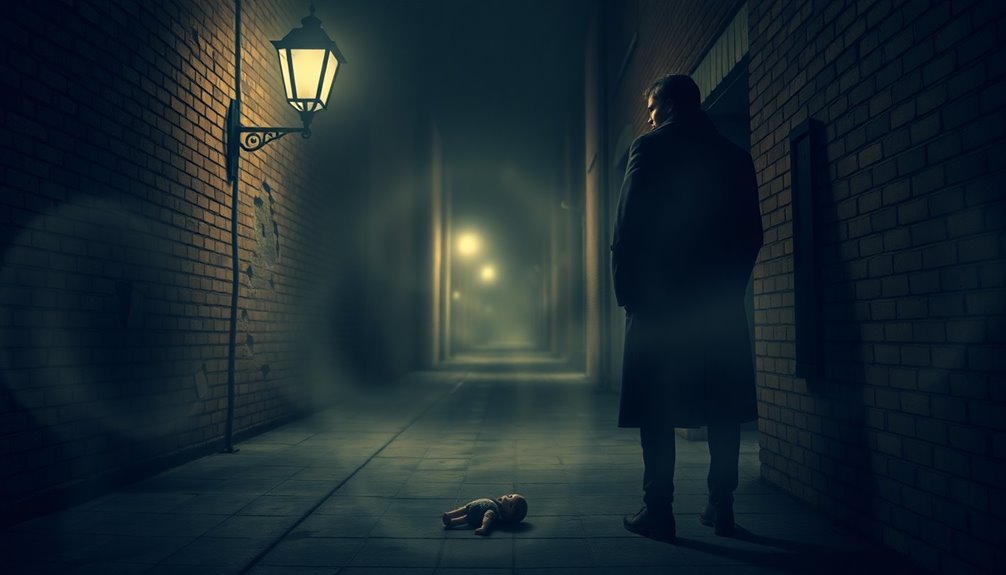In Daphne Du Maurier's 'Don't Look Now,' you're drawn into the gripping tension between grief and haunting suspense. John and Laura Baxter navigate their daughter's tragic death while in the enigmatic setting of Venice. The canals, dark streets, and eerie atmosphere amplify their emotional struggles, creating a palpable sense of dread. As John's obsession grows and Laura seeks solace in the supernatural, their relationship becomes increasingly strained. The story skillfully weaves themes of loss, jealousy, and the supernatural, leaving you on edge. Stick around to uncover how these elements shape a psychological thriller that lingers long after the last page.
Overview of the Plot
In Daphne Du Maurier's "Don't Look Now," you're drawn into the haunting story of a couple, John and Laura Baxter, who are grappling with the recent death of their daughter.
Set in Venice, the narrative structure unfolds masterfully, blending suspense with a sense of foreboding. As John and Laura explore the city, they encounter mysterious figures and unsettling events that lead to shocking plot twists. The atmosphere of Venice, much like Manderley, is steeped in a Gothic ambiance(symbolism of light and dark) that enhances the sense of mystery and dread.
The tension escalates as John's skepticism clashes with Laura's growing belief in the supernatural. Du Maurier's skillful pacing keeps you on edge, inviting you to question what's real and what's not. This exploration of psychological tension deepens the narrative's emotional depth.
Each twist deepens the exploration of their grief while propelling the narrative toward a chilling climax that leaves you reeling. Furthermore, the themes of obsession and jealousy prevalent in Du Maurier's works resonate throughout the story, adding layers to the couple's experiences.
Themes of Grief and Loss
Grief permeates Daphne Du Maurier's "Don't Look Now," shaping the characters' experiences and decisions throughout the story. You see how John and Laura cope with their profound loss, which manifests in various forms of grief expression. Their struggle reveals the complexities of mourning, illustrating that grief isn't a linear process.
- Grief can isolate individuals, affecting relationships.
- Loss coping strategies vary, from denial to acceptance.
- The impact of unresolved grief can haunt one's life. Systemic oppression deeply influences how individuals process their sorrow and navigate their lives, similar to the ways characters in "The Book Thief" showcase resilience amidst adversity.
- Shared memories can both comfort and torment.
Through the lens of grief, Du Maurier explores how the characters grapple with their emotional turmoil. This theme not only drives the plot but also deepens your understanding of their pain and resilience. The exploration of generational poverty in literature, similar to the struggles faced by characters in "A Tree Grows in Brooklyn," illuminates the pervasive nature of loss and resilience across different contexts.
The Role of Setting
Setting plays an essential role in "Don't Look Now," serving as a backdrop that amplifies the story's emotional weight. The eerie canals of Venice, shrouded in fog and mystery, create an atmospheric influence that heightens your sense of dread. The pervasive sense of surveillance and privacy mirrors the characters' feelings of being watched and judged, adding another layer of tension to the narrative. The city's dark, labyrinthine streets evoke the same sense of suspense found in Victorian mysteries, where the environment is often integral to the plot.
As you follow the characters through narrow streets and crumbling architecture, you can't help but feel the oppressive weight of their grief and loss. Du Maurier expertly uses the setting to evoke emotional resonance, pulling you deeper into the narrative.
The juxtaposition of beauty and decay mirrors the protagonists' turmoil, making each scene feel more poignant. With every twist and turn, the environment becomes a character in its own right, enriching the suspense and deepening your connection to the unfolding tragedy. Additionally, the themes of betrayal and hidden truths resonate with similar elements found in historical mysteries like "The Lost Apothecary."
Character Analysis
Characters in "Don't Look Now" are richly drawn, each grappling with their own emotional burdens while maneuvering the haunting landscape of Venice. You see how their character motivations drive the plot, revealing deep-seated fears and desires.
John is haunted by loss, while Laura seeks closure. Their emotional depth is palpable, making their experiences resonate with you.
- John's struggle with grief leads to irrational decisions.
- Laura's connection with the supernatural reflects her need for solace.
- Their relationship portrays a blend of love and despair.
- The setting amplifies their internal conflicts, enhancing the suspense.
The exploration of their emotional landscapes echoes the resilience of the human spirit found in classic literature, illustrating how trauma shapes their actions and ultimately propels the story forward. The characters' journeys reflect themes of betrayal and deception, mirroring the intricate family dynamics found in other suspenseful narratives. Additionally, the emotional turmoil they face underscores the importance of shared grief in navigating personal tragedy.
Impact on Psychological Thriller Genre
The intense emotional struggles faced by John and Laura not only drive their narrative but also leave a lasting mark on the psychological thriller genre.
"Don't Look Now" masterfully blends psychological depth with suspense, pushing the boundaries of how trauma influences human behavior. You'll notice how the narrative structure heightens psychological tension, immersing you in the characters' turmoil. This exploration of human emotions parallels the themes of disillusionment and personal struggles found in Richard Yates' work. Furthermore, the intricate psychological profiles of the characters draw parallels to the depth of female protagonists in sci-fi literature, showcasing resilience in the face of adversity.
The way Du Maurier intricately weaves their grief and paranoia creates a chilling atmosphere that resonates with readers. This approach has inspired countless authors to explore the psychological underpinnings of fear and loss, making it a cornerstone of the genre. The narrative evokes true love and fragility that mirrors the emotional rollercoaster found in other impactful stories.
Conclusion
In "Don't Look Now," the haunting red coat symbolizes both the weight of grief and the inescapable nature of loss. As you navigate the chilling twists of the plot, you can't help but feel the oppressive shadow of sorrow lurking around every corner. Du Maurier masterfully intertwines suspense with psychological depth, leaving you questioning reality itself. The story's chilling echo lingers, reminding you that sometimes, looking away can be just as perilous as facing your fears head-on.



